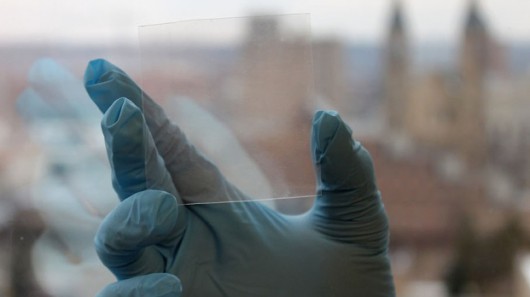
Chances are that the touchscreen on your smartphone or tablet incorporates a coating of indium tin oxide, also known as ITO or tin-doped indium oxide. Although it's electrically conductive and optically transparent, it's also brittle and thus easily-shattered. Scientists at Ohio's University of Akron, however, are developing something that could ultimately replace the material. They've created an electrode coating that's not only as transparent and more conductive than ITO, but is also far tougher.
 Chances are that the touchscreen on your smartphone or tablet incorporates a coating of indium tin oxide, also known as ITO or tin-doped indium oxide. Although it's electrically conductive and optically transparent, it's also brittle and thus easily-shattered. Scientists at Ohio's University of Akron, however, are developing something that could ultimately replace the material. They've created an electrode coating that's not only as transparent and more conductive than ITO, but is also far tougher.
Chances are that the touchscreen on your smartphone or tablet incorporates a coating of indium tin oxide, also known as ITO or tin-doped indium oxide. Although it's electrically conductive and optically transparent, it's also brittle and thus easily-shattered. Scientists at Ohio's University of Akron, however, are developing something that could ultimately replace the material. They've created an electrode coating that's not only as transparent and more conductive than ITO, but is also far tougher.
The coating, developed by a team led by assistant professor of polymer science Yu Zhu, is comprised of a network of linked copper nanowires. It can be deposited on either rigid glass or flexible clear polymer sheets.
To make it, the researchers start by depositing a copper film on the transparent substrate. Nanofibers made from a polymer known as polyacrylonitrile (PAN) are then electrospun onto that film. In order to get those fibers good and flattened-down against the film, a solvent annealing (heating and cooling) process is subsequently conducted.
Next, the coated sheet is immersed in a metal-etching solution, which removes all of the copper not protectively masked by the PAN fibers. Finally, those fibers are themselves removed, using an organic solvent that doesn't affect the copper. What's left is the glass or polymer sheet, covered in a clear layer of interconnected copper nanowires where the nanofibers shielded the film.
Sheets of transparent polymer that received the treatment retained their conductive qualities after Scotch tape had been repeatedly applied to and peeled off of the coating, and after they were bent up to 1,000 times. Because of that flexibility, it should be possible to economically mass-produce polymer touchscreens treated with the coating, in roll form.
Although other institutions have developed graphene-based transparent electrode coatings that are likewise tougher than ITO, the U Akron coating is reportedly less costly to produce. Additionally, it is produced right on the substrate, whereas graphene has to be created separately and then painstakingly transferred across (although that might not be the case formuch longer).
Other nanowire-based electrode coatings have also previously been created. According to the university, however, those fall behind Zhu's approach when it comes to adhesion, smoothness, and/or conductivity.
"We expect this film to emerge on the market as a true ITO competitor," he said. "The annoying problem of cracked smartphone screens may be solved once and for all with this flexible touchscreen."

 Previous page
Previous page Back to top
Back to top







